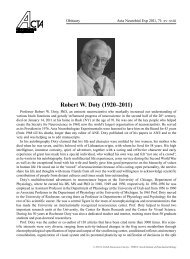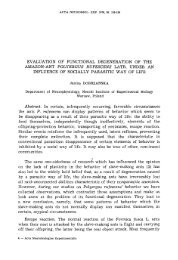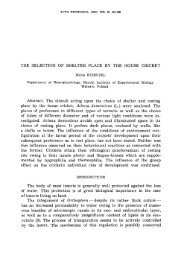Auditory perception of temporal order in centenarians in comparison ...
Auditory perception of temporal order in centenarians in comparison ...
Auditory perception of temporal order in centenarians in comparison ...
You also want an ePaper? Increase the reach of your titles
YUMPU automatically turns print PDFs into web optimized ePapers that Google loves.
374 I. Kolodziejczyk and E. Szelag<br />
identiication <strong>of</strong> <strong>temporal</strong> <strong>order</strong> <strong>of</strong> two acoustic stimuli<br />
is only possible when they are separated by an <strong>in</strong>terstimulus<br />
<strong>in</strong>terval (ISI) <strong>of</strong> approximately 20–60 ms<br />
(Hirsh and Sherrick 1961, Mills and Rollman 1980, see<br />
also Szelag et al. 2004, Wittmann and F<strong>in</strong>k 2004 or<br />
Kiss et al. 2008 for recent reviews). This <strong>in</strong>formation<br />
supports the notion <strong>of</strong> <strong>temporal</strong>ly discrete <strong>in</strong>formation<br />
process<strong>in</strong>g <strong>in</strong> a time w<strong>in</strong>dow <strong>of</strong> some tens <strong>of</strong> milliseconds.<br />
Considerable evidence on the existence <strong>of</strong> such<br />
a <strong>temporal</strong> process<strong>in</strong>g platform has been provided by<br />
experiments us<strong>in</strong>g various paradigms (see e.g. Pöppel<br />
1997, Wittmann 1999, Szelag et al. 2001 for reviews),<br />
support<strong>in</strong>g a view <strong>of</strong> a central tim<strong>in</strong>g mechanism that<br />
controls our sequenc<strong>in</strong>g abilities (Hirsh and Sherrick<br />
1961, Güçlü and Murat 2007). However, recent studies<br />
have suggested that this mechanism may be <strong>in</strong>fluenced<br />
by many procedure and subject related factors (F<strong>in</strong>k et<br />
al. 2005, F<strong>in</strong>k et al. 2006, Szymaszek et al. 2006).<br />
Although a large amount <strong>of</strong> literature has been<br />
devoted to the <strong>perception</strong> <strong>of</strong> <strong>temporal</strong> <strong>order</strong>, only a few<br />
papers have concentrated on age-related changes <strong>in</strong><br />
this task. The hypothesis <strong>of</strong> age-related deterioration<br />
<strong>in</strong> auditory sequenc<strong>in</strong>g abilities is derived predom<strong>in</strong>antly<br />
from experiments by Fitzgibbons and Gordon-<br />
Salant (1998, Gordon-Salant and Fitzgibbons 1999)<br />
who found that deficits <strong>in</strong> <strong>temporal</strong>-<strong>order</strong> judgment<br />
(TOJ) may be <strong>in</strong>creased by the stimulus complexity,<br />
i.e. sequences conta<strong>in</strong><strong>in</strong>g bidirectional frequency<br />
shifts. These studies exam<strong>in</strong>ed the TOJ <strong>in</strong> sequences<br />
<strong>of</strong> three pure tones presented <strong>in</strong> a rapid succession<br />
without any ISI, but with adaptively varied tonal durations.<br />
In a series <strong>of</strong> experiments the authors found<br />
deficits <strong>in</strong> both identification and discrim<strong>in</strong>ation <strong>of</strong><br />
<strong>temporal</strong> <strong>order</strong> <strong>in</strong> subjects aged 65–76 years, as compared<br />
with younger subjects, aged 20–40 years, but<br />
only for the most difficult stimulus sequences.<br />
Age-related deterioration <strong>in</strong> TOJ has been also<br />
observed <strong>in</strong> the studies <strong>in</strong> which two-stimulus sequences<br />
were applied. For example, Philips and coauthors<br />
(1999) found that elderly people (aged approx. 72<br />
years) needed longer ISIs than the younger ones (aged<br />
approx. 22 years) to report correctly the <strong>temporal</strong> <strong>order</strong><br />
<strong>of</strong> illum<strong>in</strong>ation <strong>of</strong> two diodes. A similar conclusion<br />
may be drawn from experiments on auditory <strong>perception</strong><br />
(F<strong>in</strong>k et al. 2005, Szymaszek et al. 2006). In these<br />
studies two stimulus presentation modes, i.e. monaural<br />
vs. alternat<strong>in</strong>g b<strong>in</strong>aural, were applied. In the monaural<br />
presentation, two identical stimuli were presented with<br />
an ISI: one stimulus was presented to the left ear and<br />
the other to the right ear and the task was to <strong>in</strong>dicate<br />
their <strong>temporal</strong> <strong>order</strong> (i.e., ‘left-right’ or ‘right-left’). In<br />
the b<strong>in</strong>aural presentation mode, two tones <strong>of</strong> various<br />
frequencies separated by an ISI were exposed to both<br />
ears and the subject was aga<strong>in</strong> asked to <strong>in</strong>dicate their<br />
<strong>temporal</strong> <strong>order</strong> (i.e., ‘high-low’ or ‘low-high’). These<br />
two modes <strong>in</strong>volve, besides TIP, also mode-specific<br />
process<strong>in</strong>g related to different underly<strong>in</strong>g processes<br />
and mechanisms. This issue was discussed <strong>in</strong> detail <strong>in</strong><br />
our earlier report (Szymaszek et al. 2006, see the<br />
Discussion section). Briefly, we found that performance<br />
<strong>in</strong> the monaural mode was more resistant (thus<br />
less deteriorated) to subjects’ age than <strong>in</strong> the b<strong>in</strong>aural<br />
mode. For the monaural mode the deterioration was<br />
not significant when compar<strong>in</strong>g the performance <strong>of</strong><br />
young (20–29-year-olds) and elderly (60–69-year-olds)<br />
listeners with normal hear<strong>in</strong>g sensitivity. In contrast,<br />
for the b<strong>in</strong>aural mode a significant age effect was<br />
observed. Similar presentation-mode <strong>in</strong>fluences were<br />
observed by F<strong>in</strong>k and coworkers (2005).<br />
The present <strong>in</strong>vestigation extends the exist<strong>in</strong>g studies<br />
on ag<strong>in</strong>g and <strong>temporal</strong> <strong>order</strong> detection to a population<br />
<strong>of</strong> extremely old subjects, i.e. Polish <strong>centenarians</strong>.<br />
Exist<strong>in</strong>g studies on age-related changes <strong>in</strong> TOJ have<br />
concentrated on subjects up to no more than 80 years<br />
<strong>of</strong> age and any evidence <strong>in</strong> older listeners is lack<strong>in</strong>g.<br />
The present experiment is a unique <strong>in</strong>vestigation <strong>of</strong> the<br />
sequenc<strong>in</strong>g abilities across a life span <strong>of</strong> 80 years, from<br />
20 to 100 years <strong>of</strong> age. In the present study the monaural<br />
presentation mode was applied because no significant<br />
decl<strong>in</strong>e for this procedure was found <strong>in</strong> earlier<br />
reports <strong>in</strong> subjects aged up to 70 years (see above).<br />
This mode, therefore, seems more resistant to agerelated<br />
deterioration <strong>in</strong> the <strong>perception</strong> <strong>of</strong> <strong>temporal</strong><br />
<strong>order</strong>.<br />
In the exist<strong>in</strong>g literature there are some <strong>in</strong>dications<br />
that sequenc<strong>in</strong>g abilities can be also modified by subjects’<br />
gender and men <strong>of</strong>ten display better performance<br />
than women <strong>in</strong> <strong>temporal</strong> <strong>order</strong> tasks (Lotze et al. 1999,<br />
Wittmann and Szelag 2003, Szymaszek et al. 2006).<br />
Thus, <strong>in</strong> the present study we analyzed the gender<br />
effect on the performance <strong>of</strong> each age group.<br />
METHODS<br />
Subjects<br />
Forty-six volunteers without previous experience <strong>in</strong><br />
the task were <strong>in</strong>cluded and divided <strong>in</strong>to 3 age groups:









